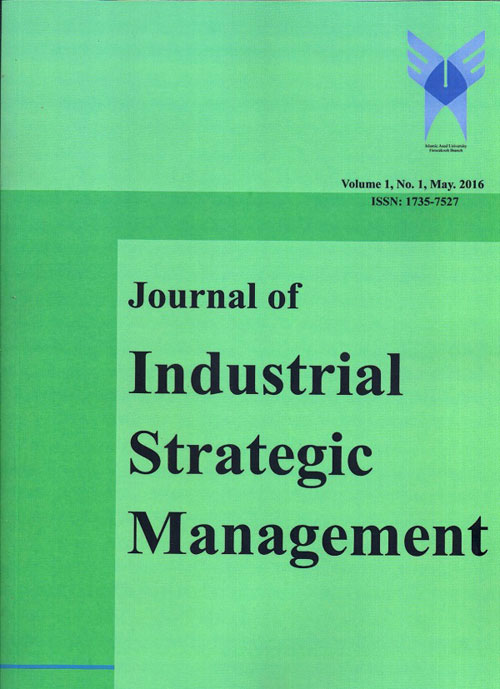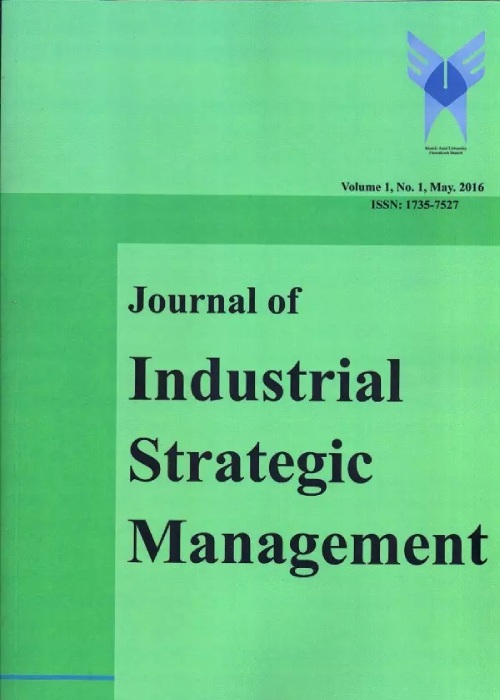فهرست مطالب

Journal of Industrial Strategic Management
Volume:7 Issue: 1, Winter 2022
- تاریخ انتشار: 1401/05/07
- تعداد عناوین: 6
-
Pages 1-11The negative impact of the COVID-19 pandemic on the survival and income of many businesses, especially those active in the hospitality industry, is very evident. The tourism industry has been severely affected by this crisis. Religious tourism has also faced a major crisis due to the closure of many hotels in the world's religious cities. Therefore, in such a situation, it is necessary to pay attention to the factors that lead to the creation of competitive advantage and hotels survival. One of the most important of these factors is marketing resources. Marketing resources improve business performance by creating competitive advantage. The purpose of this study is to rank marketing resources for hotels in the world's second-largest religious metropolis (Mashhad in Iran) during the COVID-19 pandemic. five attractive marketing resources were selected for this purpose. To determine the weight of marketing resources and rank them, the fuzzy analytic hierarchy process (FAHP) and the fuzzy analytic network process (FANP) techniques have been used. According to the obtained results, market innovation capabilities have the first priority among other resources during the COVID-19 pandemic. This finding indicates the great importance of innovation capabilities and the provision of unique new services by hotels during the COVID-19 era. The results of this study can be considered to improve the performance of hotels in the religious city of Mashhad during the COVID-19 pandemic and similar crises.Keywords: Marketing resources, FAHP technique, religious tourism, Covid-19 pandemic
-
Pages 12-21
The current era is the wonderful age of information and knowledge; the age of incredible acceleration of technology and creativity. In recent years, a wave of implementation and operation of office automation systems has swept the country and many organizations have shown a desire to use these systems. The main objective of this study is to investigate the impact of office automation systems on enhancing employee performance at Semnan Province Department of Tax Administration, Iran. This research is a descriptive-survey research in terms of method and, in terms of objective, can be classified as an applied research. The statistical population of this study is all employees of the General Department of Taxation of Semnan Province with a degree equivalent to and above high school diploma to 317 people. The statistical sampling method of this research, according to its subject and nature, is stratified sampling with appropriate allocation for employees and educational classes. The Cochran formula yielded an estimate of the sample population equal to 174 participants. Data are analyzed using the SPSS software. Diagrams have drawn by the EXCEL software and structured equations have calculated by the AMOS software. All research hypotheses are verified and the results show that the office automation system is effective in improving employee performance.
Keywords: Automation, performance, IMPROVING EMPLOYEE PERFORMANCE -
Pages 22-28
The present study aimed to investigate the impact of corporate social responsibility on innovative performance by considering the mediating role of marketing effectiveness in Khuzestan steel industries. This study is applied in terms of aim, descriptive-survey in terms of approach and causal in terms of type of research. The statistical population of the present study was all employees of Khuzestan steel industries. In this study, using a convenience random sampling method, 306 statistical samples were included in the study. The main instrument for data collection in this study was a standard questionnaire with 26 items. In this questionnaire, the answers were designed on a five-point Likert scale (from strongly disagree to strongly agree). The validity of the questionnaire was evaluated by face validity and confirmatory factor analysis, and its reliability was evaluated by calculating Cronbach's alpha coefficient. After distributing and collecting questionnaires and extracting data, descriptive and inferential analyses were performed in SPSS and LISREL Software. In this process, analyses such as Cronbach's alpha coefficient calculation, descriptive statistics on research variables, KMO test, Kolmogorov-Smirnov test, confirmatory factor analysis and path analysis were performed. Finally, the results showed that corporate social responsibility has a positive and significant impact on innovative performance and marketing effectiveness variable plays a mediating role in this regard
Keywords: Corporate Social Responsibility, innovative performance, Marketing Effectiveness, Khuzestan Steel Corporate -
Pages 29-41In this paper, the optimal interest rate on bank deposits is calculated according to monetary policy in the Iranian banking system. The interest rate on deposits is determined using the game theory and a Stackelberg game approach. The game leader is the Central Bank of the Islamic Republic of Iran, while the followers include three banks called A, B, and C. The leader of the game regulates its monetary policies in the form of three scenarios and the variables of "legal deposit award rate", "legal deposit ratio", and "rate of bank commission received" from the followers (the banking system). The follower players also determine the "interest rate on deposits" based on the strategy of the leader player. The overall results of this study indicated that in this Stackelberg game, the optimal scenario of the central bank involves "reducing the rate of commissions received" from the banking system and "increasing the legal deposit award rate" under conditions where the coefficient of the importance of the components of the utility function (social welfare) of this bank and the coefficient for facilities paid by this bank to the government, companies, banks, and governmental institutes are complete ( equalling to one), and that the scenario of changing the percentage (ratio) of the legal deposit is not optimal. Meanwhile, the optimal scenario of the follower players was reducing the interest rate on deposits in 2016. Also, the players of this game will be more profitable than their current situation if they choose Stackelberg's game.Keywords: Stackelberg game, Monetary Policies, interest rate on deposits, Iranian banking System
-
Pages 42-51
Sequencing and scheduling of production in jobshop production systems was investigated in this article. Each operation specific to a job has a random duration with a mean and variance, taking into account this uncertainty in the assumptions of the model, the adaptation of the model to the real conditions of the production environment. Each job has the operating costs of the machine during processing, the cost of equipment idle for each unit of time delay in receiving the work. In this study, the optimal scheduling is Reduction of costs. The algorithm used to solve the problem is a genetic algorithm. The efficiency of the proposed algorithms has been tested and analyzed with a number of selected problems from the literature. This study was performed in a situation where the time of operation is uncertain and follows a specific statistical distribution (normal, exponential and uniform). The performance of the genetic algorithm was evaluated based on time criteria and objective function. The results obtained from the genetic algorithm were compared with the results obtained from the combined algorithm (neural network and SA algorithm) and the results obtained from the optimal solving procedures using Lingo software version 6 for 5 sample production scheduling problems. The results show that the integrated algorithm performed better than the genetic algorithm
Keywords: jobshop production schedule, Genetic Algorithm, system -
Pages 52-60As one of the most important economic development stimuli, human capital has received great attention from many researchers. Accordingly, it is necessary to discover effective factors and the sign of their impact on human capital, particularly in Iran. Therefore, the purpose of the extant study was to examine the impact of globalization and economic sanction on the human capital of Iran for the period of 1989-2019. In this case, the effect of economic sanctions on the human capital of Iran was investigated as an innovative aspect of the present paper. The research model was designed by using independent variables, including the KOF Globalization Index, dummy variable of economic sanctions, economic growth rate, and urban population rate, and the dependent variable of average years of education as human capital. Finally, Autoregressive Distributed Lag (ARDL) method was employed to estimate the research model. The results indicated a positive impact of globalization, economic sanctions, economic growth rate, and urban population rate on the average years of education that served as the human capital index.Keywords: Globalization, Sanction, Human Capital, Autoregressive Distributed Lag (ARDL)


